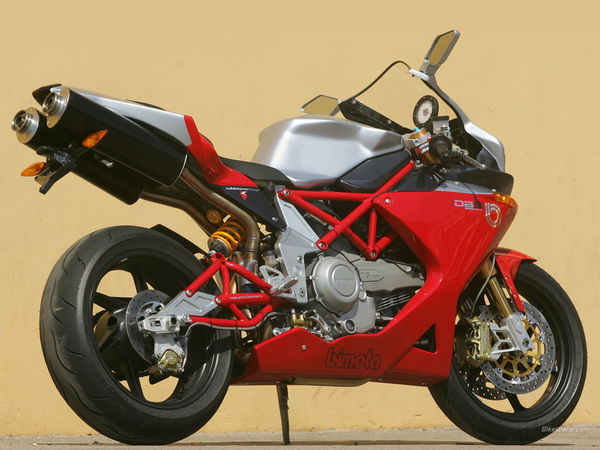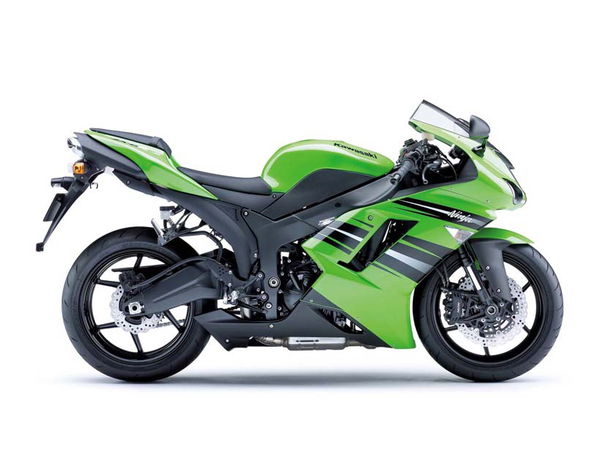DB5 review
Back once more into the fray, Bimota splash their cash on the launch of the DB5. Are you ready with yours?

If you had to pick a bike to ride at the relentlessly twisty Valencia circuit on a brutally hot Spanish summer day, a smart choice would be something light, nimble and not too powerful. Preferably also a bike to admire, cold drink in hand, between short strength-sapping sessions on track.
A bike like the Bimota DB5. Sparkling with eye-catching details, it passes the drink-in-hand test with flying colours. At a claimed 165kg dry, it's the lightest open-class bike on the market. And with an output of just 92bhp, it's quick enough to be fun but slow enough to give a few seconds' rest on Valencia's short main straight. But Bimota's main reason for launching the DB5 at a foreign grand prix circuit for the first time in the marque's history was to emphasise that Bimota is back: under fresh ownership, backed by some serious money, and ready to resume its place as purveyor of exotic motorcycles to the wealthy few. Since being taken over by Italian industrialist Roberto Comini, Bimota has begun producing small numbers of the Tesi 2D, the skeletal forkless V-twin. But it's the more conventional DB5 on which the firm's short-term future will be based. Powered by the air-cooled, 992cc engine from Ducati's SS1000DS, it's the essence of a simple, skilfully crafted V-twin sportster.
Designed by Sergio Robbiano, the DB5 lives up to the 'Italian stunner' clichès. Its frame and swingarm combine chrome-molybdenum steel tubes and aluminium plates. Milled alloy yokes hold chunky 43mm Öhlins upside-downers. Brembo calipers bolt to Bimota's own radial mounts. In Rimini tradition the SOHC, two-valves-per-pot desmo engine is internally standard. Magneti Marelli injection is modified by Bimota to suit the new exhaust system and larger, 15-litre airbox. And I might as well get the disappointing bit out of the way and say that, as tested at Valencia, the injection hadn't been modified very well. The DB5 was sweet at low revs and pulled crisply from 6000rpm, feeling distinctly smoother than I recall the Ducati did. But all five DB5s had slight glitches at the top end. Each one hesitated momentarily as its tacho needle reached a point that varied between about 7200 and 8300rpm. On the bikes with the flat-spot at higher revs it was easy enough to change up early, well before the 8700rpm limiter. More worrying, on one of the bikes I was having the engine hesitate for a split second every lap when I had my left knee-slider planted on the ground in Valencia's scary-fast penultimate turn.
The glitch took the edge off what was otherwise an impressively torquey motor with a wonderfully earthy feel. The DB5 swapped ratios sweetly through the six-speed box, not needing the top one as it trundled to indicate 130mph at the end of the short straight while I enjoyed the protection of the usefully tall screen.
Handling was good too, and promised to be excellent once the suspension was fine-tuned. That wasn't possible at Valencia as 20 riders swapped between five differently set-up bikes, and the DB5 wasn't quite as effortlessly agile as I'd expected. There's no doubt that the Bimota is very light - that 165kg figure is 14kg less than Ducati claims for the 1000DS, for example - or that it has a rigid frame and top-quality cycle parts. Given time I'm confident the Bimota would have responded well to having its steering sharpened, along with some damping adjustment to Öhlins forks that felt a few clicks away from showing their full potential. The non-rising-rate rear end was firm, very well damped and, on this smooth track at least, well up to the task of keeping the DB5's shapely tail under control. Braking was fierce, and my only slight problem was a tendency to slide forward when hard on the anchors at the end of the straight, mainly because I found it difficult to grip the narrow tank with my knees.
The DB5 is a beautiful bike with heaps of character and the potential to be both brilliantly enjoyable and relaunch Bimota as a builder of high-end motorcycles.
There is likely to be a small but strong demand for the DB5, despite a price tag of between £18,500 and £19,000. Bimota aims to build just 300 this year, of which only about 10 will reach this country. But any modern superbike must work perfectly before it goes on sale, and that's especially true of one that costs twice as much as many machines while making half as much power. Deliveries of the DB5 are due to start very soon, and it's up to Bimota to make sure the bike is fully sorted by then.
VERDICT
Small and beautifully crafted, but with glitches that need ironing out to justify the hefty price tag. Could become a classic
If you had to pick a bike to ride at the relentlessly twisty Valencia circuit on a brutally hot Spanish summer day, a smart choice would be something light, nimble and not too powerful. Preferably also a bike to admire, cold drink in hand, between short strength-sapping sessions on track.
A bike like the Bimota DB5. Sparkling with eye-catching details, it passes the drink-in-hand test with flying colours. At a claimed 165kg dry, it's the lightest open-class bike on the market. And with an output of just 92bhp, it's quick enough to be fun but slow enough to give a few seconds' rest on Valencia's short main straight. But Bimota's main reason for launching the DB5 at a foreign grand prix circuit for the first time in the marque's history was to emphasise that Bimota is back: under fresh ownership, backed by some serious money, and ready to resume its place as purveyor of exotic motorcycles to the wealthy few. Since being taken over by Italian industrialist Roberto Comini, Bimota has begun producing small numbers of the Tesi 2D, the skeletal forkless V-twin. But it's the more conventional DB5 on which the firm's short-term future will be based. Powered by the air-cooled, 992cc engine from Ducati's SS1000DS, it's the essence of a simple, skilfully crafted V-twin sportster.
Designed by Sergio Robbiano, the DB5 lives up to the 'Italian stunner' clichès. Its frame and swingarm combine chrome-molybdenum steel tubes and aluminium plates. Milled alloy yokes hold chunky 43mm Öhlins upside-downers. Brembo calipers bolt to Bimota's own radial mounts. In Rimini tradition the SOHC, two-valves-per-pot desmo engine is internally standard. Magneti Marelli injection is modified by Bimota to suit the new exhaust system and larger, 15-litre airbox. And I might as well get the disappointing bit out of the way and say that, as tested at Valencia, the injection hadn't been modified very well. The DB5 was sweet at low revs and pulled crisply from 6000rpm, feeling distinctly smoother than I recall the Ducati did. But all five DB5s had slight glitches at the top end. Each one hesitated momentarily as its tacho needle reached a point that varied between about 7200 and 8300rpm. On the bikes with the flat-spot at higher revs it was easy enough to change up early, well before the 8700rpm limiter. More worrying, on one of the bikes I was having the engine hesitate for a split second every lap when I had my left knee-slider planted on the ground in Valencia's scary-fast penultimate turn.
The glitch took the edge off what was otherwise an impressively torquey motor with a wonderfully earthy feel. The DB5 swapped ratios sweetly through the six-speed box, not needing the top one as it trundled to indicate 130mph at the end of the short straight while I enjoyed the protection of the usefully tall screen.
Handling was good too, and promised to be excellent once the suspension was fine-tuned. That wasn't possible at Valencia as 20 riders swapped between five differently set-up bikes, and the DB5 wasn't quite as effortlessly agile as I'd expected. There's no doubt that the Bimota is very light - that 165kg figure is 14kg less than Ducati claims for the 1000DS, for example - or that it has a rigid frame and top-quality cycle parts. Given time I'm confident the Bimota would have responded well to having its steering sharpened, along with some damping adjustment to Öhlins forks that felt a few clicks away from showing their full potential. The non-rising-rate rear end was firm, very well damped and, on this smooth track at least, well up to the task of keeping the DB5's shapely tail under control. Braking was fierce, and my only slight problem was a tendency to slide forward when hard on the anchors at the end of the straight, mainly because I found it difficult to grip the narrow tank with my knees.
The DB5 is a beautiful bike with heaps of character and the potential to be both brilliantly enjoyable and relaunch Bimota as a builder of high-end motorcycles.
There is likely to be a small but strong demand for the DB5, despite a price tag of between £18,500 and £19,000. Bimota aims to build just 300 this year, of which only about 10 will reach this country. But any modern superbike must work perfectly before it goes on sale, and that's especially true of one that costs twice as much as many machines while making half as much power. Deliveries of the DB5 are due to start very soon, and it's up to Bimota to make sure the bike is fully sorted by then.
VERDICT
Small and beautifully crafted, but with glitches that need ironing out to justify the hefty price tag. Could become a classic
If you had to pick a bike to ride at the relentlessly twisty Valencia circuit on a brutally hot Spanish summer day, a smart choice would be something light, nimble and not too powerful. Preferably also a bike to admire, cold drink in hand, between short strength-sapping sessions on track.
A bike like the Bimota DB5. Sparkling with eye-catching details, it passes the drink-in-hand test with flying colours. At a claimed 165kg dry, it's the lightest open-class bike on the market. And with an output of just 92bhp, it's quick enough to be fun but slow enough to give a few seconds' rest on Valencia's short main straight.
But Bimota's main reason for launching the DB5 at a foreign grand prix circuit for the first time in the marque's history was to emphasise that Bimota is back: under fresh ownership, backed by some serious money, and ready to resume its place as purveyor of exotic motorcycles to the wealthy few.
Since being taken over by Italian
industrialist Roberto Comini, Bimota has begun producing small numbers of the Tesi 2D, the skeletal forkless V-twin. But it's the more conventional DB5 on which the firm's short-term future will be based. Powered by the air-cooled, 992cc engine from Ducati's SS1000DS, it's the essence of a simple,
skilfully crafted V-twin sportster.
Designed by Sergio Robbiano, the DB5 lives up to the 'Italian stunner' clichès. Its frame and swingarm combine chrome-molybdenum steel tubes and aluminium plates. Milled alloy yokes hold chunky 43mm Öhlins upside-downers. Brembo calipers bolt to Bimota's own radial mounts.
In Rimini tradition the SOHC, two-valves-per-pot desmo engine is internally standard. Magneti Marelli injection is
modified by Bimota to suit the new exhaust system and larger, 15-litre airbox. And I might as well get the disappointing bit out of the way and say that, as tested at Valencia, the injection hadn't been modified very well. The DB5 was sweet at low revs and pulled crisply from 6000rpm, feeling distinctly smoother than I recall the Ducati did.
But all five DB5s had slight glitches at the top end. Each one hesitated momentarily as its tacho needle reached a point that varied between about 7200 and 8300rpm. On the bikes with the flat-spot at higher revs it was easy enough to change up early, well before the 8700rpm limiter. More worrying, on one of the bikes I was having the engine hesitate for a split second every lap when I had my left knee-slider planted on the ground in Valencia's scary-fast penultimate turn.
The glitch took the edge off what was otherwise an impressively torquey motor with a wonderfully earthy feel. The DB5 swapped ratios sweetly through the six-speed box, not needing the top one as it trundled to indicate 130mph at the end of the short straight while I enjoyed the
protection of the usefully tall screen.
Handling was good too, and promised to be excellent once the suspension was fine-tuned. That wasn't possible at Valencia as 20 riders swapped between five differently set-up bikes, and the DB5 wasn't quite as effortlessly agile as I'd expected. There's no doubt that the Bimota is very light - that 165kg figure is 14kg less than Ducati claims for the 1000DS, for example - or that it has a rigid frame and top-quality cycle parts.
Given time I'm confident the Bimota would have responded well to having its steering sharpened, along with some damping adjustment to Öhlins forks that felt a few clicks away from showing their full potential. The non-rising-rate rear end was firm, very well damped and, on this smooth track at least, well up to the task of keeping the DB5's shapely tail under control.
Braking was fierce, and my only slight problem was a tendency to slide forward when hard on the anchors at the end of the straight, mainly because I found it difficult to grip the narrow tank with my knees.
The DB5 is a beautiful bike with heaps of character and the potential to be both brilliantly enjoyable and relaunch Bimota as a builder of high-end motorcycles.
There is likely to be a small but strong demand for the DB5, despite a price tag of between £18,500 and £19,000. Bimota aims to build just 300 this year, of which only about 10 will reach this country.
But any modern superbike must work perfectly before it goes on sale, and that's especially true of one that costs twice as much as many machines while making half as much power. Deliveries of the DB5 are due to start very soon, and it's up to Bimota to make sure the bike is fully sorted by then.
VERDICT
Small and beautifully crafted, but with glitches that need ironing out to justify the hefty price tag. Could become a classic











